Zoom
Trash

NAVAIR - U.S. Navy Naval Air Systems Command - Navy and Marine Corps Aviation Research, Development, Acquisition, Test and Evaluation. 35 years of the Hornet F/A-18 Hornet Marks 35 Years of Flight (Navy Live blog) Feature videos All Hands Update: F/A-18 Hornet celebrates 35 years of flight U.S.
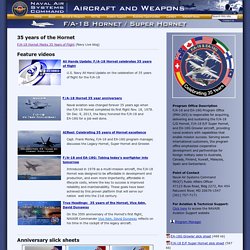
Aircraft - McDonnell Douglas/Boeing F/A-18 Hornet. McDonnell Douglas F/A-18 Hornet Role: multi-role fighter/attack aircraft Builder: McDonnell Douglas, Boeing Variants: F/A-18A, F/A-18B (two-seater), F/A-18C, F/A-18D (two seat), F/A-18E, F/A-18F (two seat), CF-18, EF-18A, RF-18Operators: US Navy, US Marine Corps, Australia, Canada, Finland, Kuwait, Malaysia, Spain, Switzerland The F/A-18 Hornet is a twin engine combat aircraft capable of carrying out both air-to-ground as air-to-air missions.
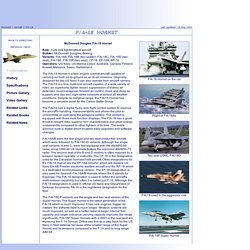
Originally designed for the US Navy it can also operate from aircraft carriers. The F/A-18 is a true multi-role aircraft capable of a wide variety of roles: air superiority, fighter escort, suppression of enemy air defenses, reconnaissance, forward air control, close and deep air support, and day and night strike missions at almost all weather conditions. Aircraft - McDonnell Douglas / Boeing F/A-18 Hornet News. F/A-18 Hornet - Military Aircraft. F/A-18E/F Super Hornet Strike Aircraft. The US Navy F/A-18 E and F Super Hornet maritime strike attack aircraft, manufactured by Boeing, flew for the first time on November 29 1995.
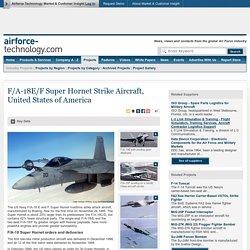
The Super Hornet is about 25% larger than its predecessor, the F/A-18C/D, but contains 42% fewer structural parts. The single-seat F/A-18/E and the two-seat F/A-18/F fly greater ranges with heavier payloads, have more powerful engines and provide greater survivability. F/A-18 Super Hornet orders and deliveries The first low-rate initial production aircraft was delivered in December 1998, and all 12 of the first batch were delivered by November 1999. In February 1999, the US Navy placed an order for 30 Super Hornets, in addition to the 12 already ordered.
"The Super Hornet is a maritime strike attack aircraft. " The first full-rate production aircraft was delivered in September 2001. A second multi-year contract was signed in January 2004 for 42 aircraft to be purchased between 2005 and 2009. Super Hornet programme and development. Boeing FA-18C/D Hornet - CombatAircraft.com. Before the F-18, no attack aircraft could match, or outperform, a fighter in the air.
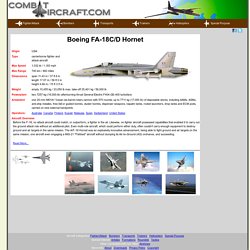
Likewise, no fighter aircraft possessed capabilities that enabled it to carry out the ground attack role without an additional pilot. Even multi-role aircraft, which could perform either duty, often couldn't carry enough equipment to destroy ground and air targets in the same mission. The A/F-18 Hornet was an explosively innovative advancement, being able to fight ground and air targets on the same mission, one aircraft even engaging a MiG-21 "Fishbed" aircraft without dumping its Air-to-Ground (AG) ordnance, and succeeding. The F/A-18's beginnings were far from humble. After a request was issued for a new affordable fighter with multi-role capabilities that would serve with the USAF as well as allied air forces, Northrop submitted their YF-17 Cobra against Lockheed Martin's F-16 Fighting Falcon (Unofficially named the Viper).
Written by: Pace51. Royal Canadian Air Force announces pilot and theme for 2014 CF-18 Demo Team. News Article / November 28, 2013 Royal Canadian Air Force The Royal Canadian Air Force is pleased to announce the appointment of Captain Adam “Manik” Runge as the pilot for the 2014 CF-18 Demonstration Team.
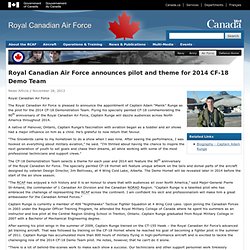
Flying his specially painted CF-18 commemorating the 90th anniversary of the Royal Canadian Air Force, Captain Runge will dazzle audiences across North America throughout 2014. A native of Hanover, Ontario, Captain Runge’s fascination with aviation began as a toddler and air shows had a major influence on him as a child. He’s grateful to now return that favour. “The Snowbirds came to my hometown to do a show when I was nine.
The CF-18 Demonstration Team selects a theme for each year and 2014 will feature the 90th anniversary of the Royal Canadian Air Force. “The RCAF has enjoyed a rich history and it is an honour to share that with audiences all over North America,” said Major-General Pierre St-Amand, the commander of 1 Canadian Air Division and the Canadian NORAD Region. Fact File: F/A-18 Hornet strike fighter. BackgroundThe F/A-18 demonstrated its capabilities and versatility during Operation Desert Storm, shooting down enemy fighters and subsequently bombing enemy targets with the same aircraft on the same mission, and breaking all records for tactical aircraft in availability, reliability, and maintainability.
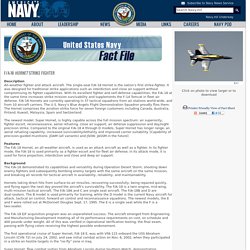
Hornets taking direct hits from surface-to-air missiles, recovering successfully, being repaired quickly, and flying again the next day proved the aircraft's survivability. F/A-18 Hornet Fighter. McDonnell Douglas F/A-18 Hornet. The McDonnell Douglas (now Boeing) F/A-18 Hornet is a twin-engine supersonic, all-weather carrier-capable multirole combat jet, designed as both a fighter and attack aircraft (F/A designation for Fighter/Attack).

Designed by McDonnell Douglas and Northrop, the F/A-18 was derived from the latter's YF-17 in the 1970s for use by the United States Navy and Marine Corps. The Hornet is also used by the air forces of several other nations. The U.S. Navy's Flight Demonstration Squadron, the Blue Angels, has used the Hornet since 1986. The F/A-18 has a top speed of Mach 1.8 (1,190 mph or 1,915 km/h at 40,000 ft or 12,190 m). The Hornet saw its first combat action in 1986 during Operation El Dorado Canyon and subsequently participated in 1991 Operation Desert Storm and 2003 Operation Iraqi Freedom. Development[edit] Origins[edit] The U.S. In August 1973, Congress mandated that the Navy pursue a lower-cost alternative to the F-14. Redesigning the YF-17[edit] Northrop's F-18L[edit] Design[edit]
Boeing F/A-18E/F Super Hornet. The Boeing F/A-18E Super Hornet and related twin-seat F/A-18F are twin-engine carrier-capable multirole fighter aircraft variants based on the McDonnell Douglas F/A-18 Hornet.
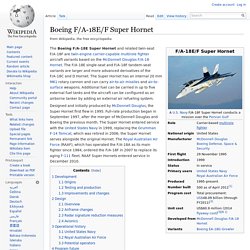
The F/A-18E single-seat and F/A-18F tandem-seat variants are larger and more advanced derivatives of the F/A-18C and D Hornet. The Super Hornet has an internal 20 mm M61 rotary cannon and can carry air-to-air missiles and air-to-surface weapons. Additional fuel can be carried in up to five external fuel tanks and the aircraft can be configured as an airborne tanker by adding an external air refueling system.
Designed and initially produced by McDonnell Douglas, the Super Hornet first flew in 1995. Full-rate production began in September 1997, after the merger of McDonnell Douglas and Boeing the previous month. Development[edit] Origins[edit] F/A-18E/F Super Hornet. The F/A-18E/F Super Hornet is a combat-proven strike fighter with built-in versatility.
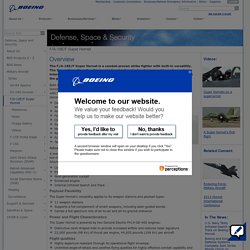
The Super Hornet's suite of integrated and networked systems provides enhanced interoperability, total force support for the combatant commander and for the troops on the ground. Both the single seat E and two-seat F models convert quickly from one mission type to the next with the flip of a switch to provide consistent air dominance: Day/night strikes with precision-guided weaponsAnti-air warfareFighter escortClose air supportSuppression of enemy air defenseMaritime strikeReconnaissanceForward air controlTanker A menu of advanced capabilities available for retrofit or for new aircraft orders is the affordable, low-risk approach that the F/A-18 team is taking to stay ahead of threats now and well into the future.
Advanced options include: Conformal fuel tanksEnclosed weapons podNext-generation cockpitEnhanced engineInternal Infrared Search and Track.